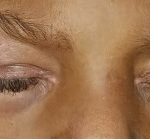Introduction & Objectives
Interstitial lung disease (ILD) accompanied by anti-melanoma differentiation-associated gene 5 (MDA5) positive dermatomyositis (DM) is often rapidly progressive and associated with poor prognosis. A standard treatment has not yet been established. The 6-month survival rate of patients undergoing conventional treatment with glucocorticoids (GC) alone or a combination of GC and additional various immunosuppressants (step-up therapy) is 28–66% in Asian patients. Failure of these treatments seems to be partly related to rapid progression in alveolar damage before achieving sufficient immunosuppression.
Recently, some case reports have suggested a combined immunosuppressive therapy may be efficacious. Thus, in a single-arm study, these researchers prospectively evaluated the efficacy and safety of a combined immunosuppressive regimen for anti-MDA5-positive DM with ILD.
Methods
Adult Japanese patients with newly onset anti-MDA5-positive DM with ILD (n=29) were enrolled in multiple centers from 2014 to 2017. They were treated with a regimen of high-dose glucocorticoids (GC), tacrolimus and intravenous cyclophosphamide (IVCY). Plasmapheresis (i.e., plasma was removed, then replaced with an equivalent amount of fresh frozen plasma or 5% albumin) was used if patients worsened after the regimen started. The primary endpoint was six-month survival, compared with that of a historical control (n=15) of patients with anti-MDA5-positive DM with ILD who received step-up treatment (high-dose GC and stepwise addition of immunosuppressant). Secondary endpoints were 12-month survival rate, adverse events and changes in laboratory data.
Two patients dropped out of the treatment regimen because their treatment differed from that of the prescribed regimen during the observation period: Administration of IVCY was considerably delayed for one patient, and IVCY was changed to infliximab for the other patient.
Results
The combined immunosuppressive regimen group showed significantly higher 6-month survival than the step-up treatment group (89% and 33%, respectively, P<0.0001). In the combined immunosuppressive group, 23 of 27 patients survived. In the step-up treatment group, 10 of 15 patients died.
Over 52 weeks, anti-MDA5 titer, serum ferritin level, percent vital capacity and chest high-resolution computed tomography scores improved. The combined immunosuppressive regimen group received IVCY nearly 20 days earlier with shorter intervals and tended to receive plasmapheresis more often than patients undergoing step-up treatment (n=15). Cytomegalovirus reactivation was frequently observed over 52 weeks.
All survivors recovered to a state in which oxygenation was not required. All deaths were due to exacerbation of ILD; however, infections seemed to trigger the exacerbation.
Conclusion
A combined immunosuppressive regimen is effective for anti-MDA5-positive DM with ILD. Plasmapheresis can be used for additional effect in intractable disease. Opportunistic infections should be carefully monitored during treatment.
Refer to the full study for all source material.


